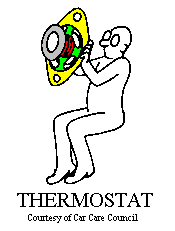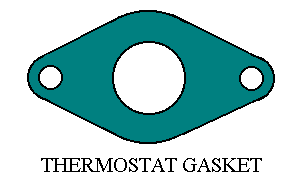Replacing Your Thermostat
*HARD*
Expect to replace your thermostat after 4-5 years or when it becomes defective. Use this procedure to change your thermostat:
- Park the vehicle on level ground with the engine OFF, the parking brake engaged, and the transmission in PARK (for automatic) or REVERSE (for manual). If the engine has been run recently, let it cool. Raise the hood.
- Identify the location of the thermostat from your owner's manual. It is usually on top of the engine block immediately behind the water pump. The thermostat is underneath the thermostat housing, which is connected to the radiator by the upper radiator hose.
- Remove the radiator cap. Place a container underneath the radiator draincock and loosen the draincock by turning it counterclockwise. Drain enough coolant so the level in the radiator is below the thermostat housing. Draining one or two gallons of coolant should be sufficient. Tighten the radiator draincock and save the drained coolant.
- Use a socket wrench to remove the thermostat housing bolts from the engine block. Pull the thermostat housing away from the engine. If it is stuck, break it loose with gentle taps from a rubber mallet. If a rubber mallet is not available, place a piece of wood over the housing and tap it with a regular hammer. Stuff a clean rag in the thermostat opening to prevent dirt from getting inside the engine.
- Turn the thermostat housing upside-down and remove the thermostat by pulling it out. You may need to rotate the thermostat counterclockwise as well. Never pry the thermostat from its housing; the sealing surface could be damaged. Note the position of the thermostat prior to its removal from the housing in order to prevent incorrect installation of the replacement part.
- Gently remove any gasket material that may remain on the housing or engine block with a putty knife or similar tool. Do not gouge the metal surfaces or permit gasket residue to fall into the engine block. Clean the sealing surfaces with solvent if the residue is particularly stubborn. Both surfaces must be clean and smooth to prevent coolant leaks. Remove the rag from the engine block opening.
- Install the new thermostat in the engine block. The thermostat return
spring should be facing downward although it may be obscured. Do not install it
upside-down or the engine will overheat.
- Place a new thermostat housing gasket on the engine block opening. If the
gasket comes with an adhesive backing, remove the protective cover first and
place it on the engine block, sticky side down. If the gasket is of a
non-adhesive variety, coat the engine block sealing surface with a thin layer of
gasket sealant first. Make sure the gasket is not wrinkled and that its two
holes align perfectly with the engine block holes. Apply sealant to the top
surface of the gasket in either case.
- Attach the thermostat housing (with thermostat) to the engine block using a socket wrench and both attaching bolts. Install the bolts simultaneously. Consult your owner's manual for correct torque specification. Do not tighten excessively, or the bolt threads could be stripped and the housing might leak.
- Use a large, wide-mouthed funnel to pour previously drained coolant back into the radiator. Tighten the radiator cap.
- Start the engine and run it in a well-ventilated area until it reaches normal operating temperature. The upper radiator hose should suddenly become hot to the touch. Check the thermostat housing for any coolant leaks. If leaks are observed, shut off engine and tighten housing bolts or hose clamp accordingly. Close the hood.

